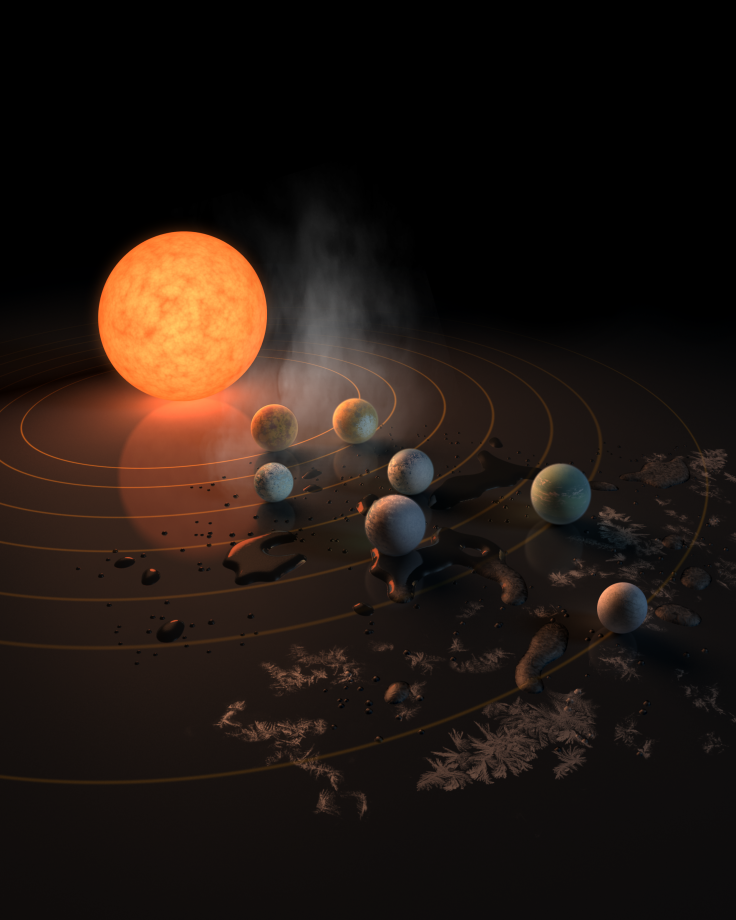Hunt For Alien Life? Red Dwarf Stellar Flares May Have Made TRAPPIST-1 Planets Uninhabitable

Life, as we currently understand it, is fragile. A lot of factors need to be just right for life on a planet to emerge, including the planet’s distance from its parent star and the class of star the object revolves around.
Take a red dwarf, for instance. These are the most common and the longest-lived stars in the universe, and the last generation of these objects are likely to remain aglow for 10 trillion years. While their longevity makes them the most common stars in the universe and thus ideal candidates, probabilistically, for hosting planets with life, these stars come with their own baggage. When they are young, they emit strong flares and ultraviolet radiation that can strip the atmosphere from any rocky world in the habitable zone.
Read: Red Dwarfs: The Cradle Of Alien Life?
This finicky nature of red dwarfs may have doomed the chances of life as we know it to evolve in the planets in TRAPPIST-1 — a solar system containing seven Earth-sized planets, at least three of which are in the habitable zone. The problem, according to an analysis of luminosity patterns in the raw photometric data of TRAPPIST-1 (gathered by NASA’s Kepler Space Telescope), is that this star is a red dwarf, and like any red dwarf, it flares too frequently and too powerfully to be conducive to life around it.
A team of researchers that perused data gathered over an 80-day period detected 42 high-energy flares — 12 percent of which were “many-peaked” eruptions. Scientists believe that these events were the result of stellar magnetism, which causes magnetic flux ropes to reconnect in the star’s atmosphere, releasing, in the process, bursts of energy.
“The energy distribution of the 42 observed flares shows that TRAPPIST-1 belongs to the more active group of M-dwarfs,” the Konkoly Observatory in Hungary, whose researchers were involved in carrying out the observations, said in a statement released Tuesday. “The strongest eruption emitted energy at roughly 1033 ergs in white light, which is in the order of the largest flare ever observed on the sun, the so-called ‘Carrington-event’ in 1859 that caused auroras in the tropical regions and set telegraph lines on fire.”
More worryingly, the average gap between flares was just 28 hours — which makes the high-energy bombardment more or less continuous.
“It is possible however, that a sufficiently strong magnetic field of the orbiting exoplanet could shield the atmosphere from the harmful effects of such eruptions,” the researchers wrote in a study detailing the observations. “Kay, Opher, & Kornbleuth (2016) found that for typical coronal mass ejection (CME) masses and speeds measured on M dwarfs, the orbiting rocky planets would need magnetic fields between tens to hundreds of Gauss, while hot Jupiters would only require magnitudes between a few and 30 G.”
Optimistically, this means all hope is not lost. Pessimistically, given that the magnetic field needed for life on the planets’ surface to survive these flares is many orders of magnitude higher than Earth’s (which is only about 0.5 Gauss), life probably never had the chance to evolve on any of the planets in the TRAPPIST-1 system.
The study, which has been submitted to the Astrophysical Journal for review, is available online at the preprint server arXiv.
© Copyright IBTimes 2024. All rights reserved.






















